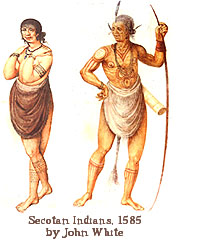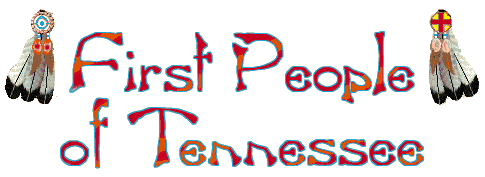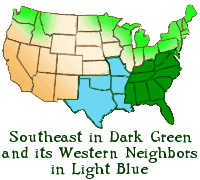
During the federal period of Indian land cessions in the
American Southeast (1785-1835), only these First People ceded land to the United
States.
Appalachicola, Cherokee, Chickasaw, Choctaw, Creek, and Seminole.
Of course,
there were earlier pre-federal cessions and accommodations, those made to the British
colonial governments, and potentially, colonial Spanish and French colonial governments.
Still, there are too many people listed above that are not
covered by the cessions and that causes us to ask, “where have they gone?”
Many First People were devastated by imported European
diseases, some were wiped out by warfare with the colonials or with other tribes.
The Natchez were almost
destroyed by warfare with the French (1729). The Shawnee were driven from the
Cumberland River basin to
north of the Ohio River by a temporary confederation of the Cherokee and
Chickasaw (1714-1715).
Some tribes were greatly damaged by enslavement.
In the
Carolinas, the colonials, often with the help of other tribes, enslaved the Indians
and sold them into slavery
to be shipped off to Caribbean for plantation work.
Many tribes were later absorbed by other tribes, becoming
totally assimilated. Others joined other tribes, The Yuchi were driven from the Great
Valley of the Tennessee
by the Cherokee. They affiliated with the Creek Nation and so, the Yuchi became
silent party to Creek cessions.
Some First People “intermarried with the white traders,
trappers, and packmen, who joined their tribes. Some of these men even had white wives
back in the colonial
settlements but they also had their Indian families back in the frontiers. There are
few true southerners who do not
have traces of Indian blood in their veins though many are not aware of it as our
ancestors did not want people to
know there was Indian blood.”*
(*Gloria Holback)
Often, the First People would hold slaves, both from
other tribes,
and later, African-American slaves. Some slaves would also escape from white
plantations
and seek protection
by joining with Indian Nations. There they would intermarried with the Indians.
The First People who have otherwise disappeared
may still have a genetic connection to white, Indian, and/or African-American
families.
Also See:
Federally Recognized Tribes /
First Nations
with Historical ties to Tennessee

Accohanoc, member of the Powhatan Confederacy, Accomao and part of Northampton Counties,
Virginia, and probably extending slightly into Maryland. (JS)
Accomac (Accomàcks), member of the Powhatan Confederacy, southern part of
Northampton County, Virginia. (JS)
Acuera;
Adai;
Ais;
Akokisa;
Alabama (Ma’-mo an-ya-di, Ma’-mo han-ya, Oke-choy-atte), upper waters
of the Alabama River,
Alabama. LF: Muskogean.
Alibamous;
Appalachee;
Appalachicola;
Appomattoc (Appamàttocs), member of the Powhatan Confederacy, Bermuda Hundred area,
Chesterfield County Virginia. (JS)(TJ)
Arrohattoc (Arrowhàtocs), member of the Powhatan Confederacy, Henrico County.
Chesapeake, in Princess Anne County. (JS)(TJ)
Atasi;
Atkapa;
Avoyel;
Bayogoula;
Bidai;
Biloxi;
Blackfoot (see
Sissipaha).
Cahinnio, a Caddo tribe connected with the Kadohadacho confederacy.
Calusa;
Catawba;
Chatawhatchee;
Chatot;
Chawasha;
Cheraw, (Saraw, Sara, Xula);
Cherokee (Ani-Yun’ wiya, Tsalagi);
Chèsapeaks;
Chiaha;
Chiakanessou;
Chickahominy, (Chickahòminies), member of the Powhatan Confederacy,
Chickahominy River, Virginia. (JS)(TJ)
Chickasaw (Chicasa);
Chilucan;
Chine;
Chiskiac (Chìskiacs), member of the Powhatan Confederacy, York County Virginia.
Chitimacha;
Chkchiuma;
Choctaw;
Choula;
Chowanocs, North Carolina, LF: Algonquian;
Congaree;
Coosa;
Coree (Coranine);
Cosapuya;
Coweta;
Creek (Muscogee),
during historic times, most of the Muscogee population
was concentrated into two geographical areas and became known under the names the English
applied to them. The Muscogee people occupying the towns on the Coosa
and the Tallapoosa Rivers became the Upper Creeks, and those to the southeast, on the
Chattahoochee and Flint Rivers, became the Lower Creeks. LF: Muskogean.
Cusabo;
Cuttatawomen, member of the Powhatan Confederacy, King George County Virginia.
(JS)(TJ)
Deadose;
Doustioni;
Eno;
Eufaula (Yufala);
Eyeish (Ha-ish);
Fresh Water (Agua Dulce);
Fus-hatchee;
Gingaskin;
Grigra (Gris);
Guacata;
Guale;
Guasco;
Hainai;
Hassinungaes;
Hatteras;
Hilibi;
Hitchiti (also see Seminole).
Houma;
Ibitoupa;
Icafui;
Ioquois (Nottaway);
Jeaga (Hayaga);
Kadohadacho;
Kan-hatki;
Kaskinampo;
Kealedji;
Kecougtans (Kecoughtáns), member of the Powhatan Confederacy,
Elizabeth City County area,
Virginia. LF: Algonquian.
Keyauwee;
Kiskiack, member of the Powhatan Confederacy, Chesapeake Bay region, Virginia.
LF: Algonquian.
Koasati;
Kolomi (Kulumi);
Koroa;
Lumbee (Cheraws); North Carolina.
Macapirs, (Macapiras);
Machapunga;
Manahoac (Mannahoacs);
Mandoag (Manadoak), not a nation but an epithet employed by Algonquian speakers
to designate foreign,
generally enemy, nations. (LM)
Massinacacs;
Mattoponis (Màttapomènts Mattapony), member of the Powhatan Confederacy,
Mattoponi
River area, King William County, Virginia. LF: Algonquian. (JS)(TJ)
Meherrin (Maharinect);
Mikasuki;
Mobile;
Mococo (Mucoco);
Mohemenchoes;
Monacans;
Monahassanoes;
Monasiccapanoes;
Moneton;
Monocan;
Moratok;
Moraughtacund (Moràughtacuttds), member of the Powhatan Confederacy,
Moratico River area,
Lancaster and Richmond Counties Virginia. (JS)(TJ)
Mummapacune, York River area, Virginia. (JS)
Mugulasha (Quinipissa);
Muklasa;
Muskogee (see Creek).
Nabedache;
Nacachau;
Nacanish;
Nacogdoche;
Nacono;
Nahyssan;
Nanatsoho;
Nansamònds;
Nantaughtacunds;
Napochi (Nabochi);
Nansemond (Nansamònds), member of the Powhatan Confederacy, Nansemond County,
Virginia. (JS)
Nasoni;
Natasi;
Nantaughtacund , member of the Powhatan Confederacy, Essex and Caroline Counties,
Virginia. (JS)
Natchez;
Natchitoches;
Nautaugue;
Nechaui;
Neche;
Neusiok;
Nittagwwga;
Notowega, a Band of Chickamauga Creek.
Nottoway;
Ocale;
Occaneechi, North Carolina.
Ocita (Ucita);
Oconee;
Ofo;
Ofogoula;
Okchai;
Okelousa;
Okmulgee;
Onatheaqua;
Onawmanient (Onaumanìents), member of the Powhatan Confederacy,
Westmoreland County. (JS)(TJ)
Ontponies;
Opelousa;
Opillako;
Osochi;
Pakana;
Pamlico;
Pamunkey (Pamùnkies), member of the Powhatan Confederacy, Chesapeake
Bay region, King William
County, Virginia. LF: Algonquian.
Pascagoula;
Paspahegh (Paspahèghes), member of the Powhatan Confederacy, Charles
City and James City Counties
Virginia. (JS)(TJ)
Patiri;
Pataunck, member of the Powhatan Confederacy, Pamunkey River Virginia. (JS)
Patôuvomekes;
Pawokti;
Payagrave;nkatanks;
Pedee;
Pensacola;
Piankatank, Piankatank River, Virginia.
Pissasee (Pissasecs), member of the Powhatan Confederacy, King George and
Westmoreland Counties, Virginia. (JS)
Piscataway (Pitcataway, Conoy);
Pithlako, Pohoy, Pooy, Pojoi (Posoye);
Potano;
Potomac, member of the Powhatan Confederacy, Stafford and King George Counties,
Virginia. (JS)
Powhatan, Powhatàn. Powhatan Confederacy, the name is applied to the tribe
(Henrico County) as well as to the group and also to its leader, Wahunsonacock.
Chesapeake Bay region and Potomac River area, Virginia. LF: Algonquian.
Quapaw;
Quinipissa;
Quiocochànocs;
Rappahannock (Rappahànocs), member of the Powhatan Confederacy, Richmond
County Virginia. (JS)(TJ)
Saluda;
Santee;
Saponi;
Saturiwa;
Sawokli;
Secacawoni (Secacaonics), member of the Powhatan Confederacy, Northumberland County,
Virginia. (JS)(TJ)
Secotan, North Carolina, LF: Algonquian.
Seminole.
“ ... In the dishonorable record of our dealings with
the Indians there is
perhaps no blacker chapter than that relating to the Seminole people. These
are a Muskhogean tribe, originally made up of emigrants from the Lower Towns
on the Chattahoochee river who moved down into Florida after 1700; at first classed
with the Lower Creeks, about 1775 they began to be known as Seminole, meaning
‘separatist’ or ‘runaway.’ They consisted chiefly of
descendants of Muskogee (Creeks) and Hitchiti, with a considerable number of
refugees from the Upper Creeks together with Yamasee and other conquered tribes,
Yuchi, and a large negro element from runaway slaves ... ” (
GF)
Sewee, Santee River area, South Carolina. LF: Siouan.
Shackakonies;
Shakori;
Shawnee (Shawano, Shawanese, Shawanoe, etc.);
Sissipaha (Sissipahaw), Haw River area, North Carolina. LF: probably
Siouan.
Some descendants of mixed blood have been known as Blackfoot - not to be confused with
the recognized
Blackfeet of the U.S northern great plains and Canada, nor the unrecognized Blackfoot of
Montana.
Soacatino (Xacatin);
Stegarakies;
Sugaree;
Surruque (Horruque, Surreche);
Tacatacuru;
Taensa;
Tamathli;
Tamali;
Tangipahoa;
Taposa;
Tauxenent (Tauxenents), member of the Powhatan Confederacy, Fairfax County, Virginia.
(JS)(TJ)
Tauxitanians;
Tawasa;
Tegninaties;
Tehahnahmah, a migratory people, currently the main group is located in Tennessee and a small
band is located in Florida. LF: unknown, an “isolate.”
Tekesta (Tequest);
Thome;
Timucua group;
Tiou;
Tobcobaga;
Tukabahchee;
Tunica;
Tuscarora;
Tuskegee;
Tutelo, North Carolina, a Monocan subtribe. LF: Siouan. (LM)
Utina (Timucua);
Waccamaw;
Wacoma (Lumbee); Drowning Creek, Lumbee River, North Carolina
Wakokai;
Warrasqueoc (Warraskoyak, Wàrrasqeaks), member of the Powhatan Confederacy,
Isle of Wight County,
Virginia. LF: Algonquian.
Washa (Quacha);
Washita (Quachita);
Wateree;
Waxhaw;
Weanoe, member of the Powhatan Confederacy, Charles City County Virginia. (JS)
Weapemeoc, North Carolina, LF: Algonquian.
Wènocs;
Werowcomoco, member of the Powhatan Confederacy, Gloucester County, Virginia. (JS)
Wèrowocograve;micos;
Whonkenties;
Wicocomoco, member of the Powhatan Confederacy, Northumberland County, Virginia. (JS)
Wighcocòmicoes;
Winyaw;
Wiwohka;
Woccon;
Yadkin;
Yamasee;
Yatasi;
Yazoo;
Yeopim (Weapemeoc);
Yfera;
Youghtanund, member of the Powhatan Confederacy, Pamunkey River, Virginia. (JS)
Ystaga (Hostaqua);
Yuchi (Euchee, Uchee);
Yui (Spanish: Ibi;
(From an original list by
Donald Panther-Yates, Thomas Jefferson’s Notes on the State of
Virginia, and with a great many additions from Gloria Holback.)
Sources:
(GF) Foreman, Grant, Indian Removal, (Vol. 2 - The Civilization
of the
American Indian series) University
of Oklahoma Press, 1932, 1953.
(TJ) Jefferson, Thomas, Notes on the State of Virginia, 1784, New York; M. L.
&
W. A. Davis, 1801
(LM) Miller, Lee, Roanoke, Solving the Mystery of the Lost Colony, Acade
Publishing, New York, first
American edition, 2001, ISBN: 1-55970-584-1.
(CR) Royce, Charles C., Indian Land Cessions in the United States, Powell, J. W.,
(director), “Eighteenth Annual Report
of the Bureau of American Ethnology - 1896-‘97”, Vol II.
(JS) Swanton, John Reed, Indian Tribes of the Lower Mississippi Valley,
Bureau of American Enthology, Bulletin 43, 1909.
(JS) Swanton, John Reed, The Indian Tribes of North America, Bureau of
American Ethnology Bulletin 145, 1953.
(JS) Swanton, John Reed, The Indians of the Southeastern United States. ,
Bureau of
American Ethnology Bulletin 137, 1946.
Bio: John Reed Swanton, 1873-1958. Born Gardiner, Maine. Graduated Harvard University,
1896, received his Masters Degree
the following year. Employed by the Bureau of American Ethnology where he worked as
editor of
the American Anthropologist and as president of American Anthropological Association.
He authored many more
books than what we listed above.









